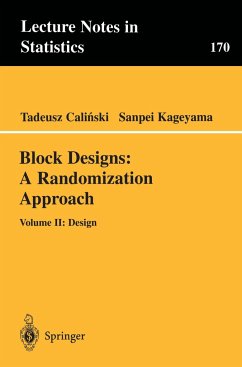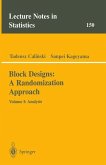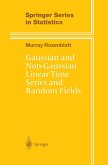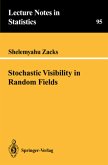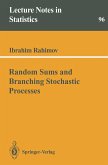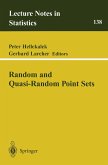This volume will deal with the constructions of block designs. Tadeusz Calin'ski taught statistics, biometry and experimental design at the Agricultural University of Poznan' from 1953 to 1988. He obtained the title of Professor of Natural Sciences in 1974. He was head of the Department of Mathematical and Statistical Methods from 1968 to 1984 and is now Professor Emeritus. In 1998 Professor Calin'ski was awarded the doctoral Degree honoris causa by the Agricultural University of Poznan'. He has published over 140 articles in scientific journals. He has served on the editorial boards of the Journal of Statistical Planning and Inference, Biometrics, and several Polish scientific journals. Sanpei Kageyama has been Professor of Statistics and Discrete Mathematics in the Department of Mathematics, Hiroshima University, Japan, since 1992. He has published over 240 articles in scientific journals. Professor Kageyama is a Foundation Fellow of the Institute of Combinatorics and its Applications, and a council member of the Mathematical Society of Japan. He has served on the editorial boards of the Journal of Japan Statistical Society, Utilitas Mathematics, and the Journal of Statistical Planning and Inference.
The book is composed of two volumes, each consisting of five chapters. In Vol ume I, following some statistical motivation based on a randomization model, a general theory of the analysis of experiments in block designs has been de veloped. In the present Volume II, the primary aim is to present methods of that satisfy the statistical requirements described in constructing block designs Volume I, particularly those considered in Chapters 3 and 4, and also to give some catalogues of plans of the designs. Thus, the constructional aspects are of predominant interest in Volume II, with a general consideration given in Chapter 6. The main design investigations are systematized by separating the material into two contents, depending on whether the designs provide unit efficiency fac tors for some contrasts of treatment parameters (Chapter 7) or not (Chapter 8). This distinction in classifying block designs may be essential from a prac tical point of view. In general, classification of block designs, whether proper or not, is based here on efficiency balance (EB) in the sense of the new termi nology proposed in Section 4. 4 (see, in particular, Definition 4. 4. 2). Most of the attention is given to connected proper designs because of their statistical advantages as described in Volume I, particularly in Chapter 3. When all con trasts are of equal importance, either the class of (v - 1; 0; O)-EB designs, i. e.
The book is composed of two volumes, each consisting of five chapters. In Vol ume I, following some statistical motivation based on a randomization model, a general theory of the analysis of experiments in block designs has been de veloped. In the present Volume II, the primary aim is to present methods of that satisfy the statistical requirements described in constructing block designs Volume I, particularly those considered in Chapters 3 and 4, and also to give some catalogues of plans of the designs. Thus, the constructional aspects are of predominant interest in Volume II, with a general consideration given in Chapter 6. The main design investigations are systematized by separating the material into two contents, depending on whether the designs provide unit efficiency fac tors for some contrasts of treatment parameters (Chapter 7) or not (Chapter 8). This distinction in classifying block designs may be essential from a prac tical point of view. In general, classification of block designs, whether proper or not, is based here on efficiency balance (EB) in the sense of the new termi nology proposed in Section 4. 4 (see, in particular, Definition 4. 4. 2). Most of the attention is given to connected proper designs because of their statistical advantages as described in Volume I, particularly in Chapter 3. When all con trasts are of equal importance, either the class of (v - 1; 0; O)-EB designs, i. e.

